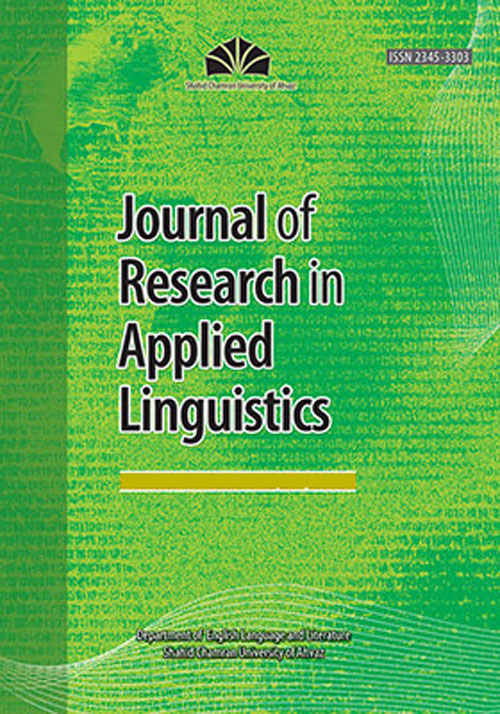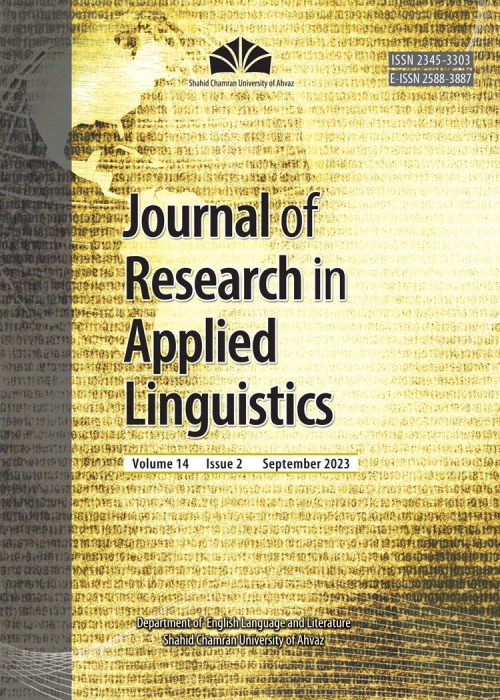فهرست مطالب

Journal of Research in Applied Linguistics
Volume:7 Issue: 2, Autumn 2016
- تاریخ انتشار: 1395/05/10
- تعداد عناوین: 8
-
-
Page 3Action research is a small-scale intervention in the functioning of the real world to address practitioners own issues and carry out a close examination of the effects of such an intervention. Classroom-based research, or action research, can be the viable solution to some pandemic academic sluggishness and scientific apathy. However, the erroneous impression that research is an elite discipline belonging to certain talented or conversely boring individuals who always constrain themselves to their desks dissuades some teachers from engaging with action research in the local contexts. This small scale qualitative study was an attempt to investigate the reasons that hamper the Iranian EFL teachers teaching in language institutes to do action research. To this end, a total of 12 Iranian EFL teachers (8 females and 4 males) were chosen through the convenience sampling procedure to take part in the study. The semistructured individual interviews were used to gather the data. Results of the content analysis revealed that such factors as (a) attitude toward action research, (b) lack of fund and support, (c) lack of cooperation among colleagues, and (d) lack of knowledge and confidence in doing action research led to the teachers apathy in regard to doing action research.Keywords: Action Research, Iranian EFL Teachers, Classroom, Based Research
-
Page 16This study aims to present an accessible model of some frequent nonfinite adverbial types occurring in English prose fiction. As its main syntactic argument, it recognizes that these adverbials are mostly elliptical in that there are some dependent-clause markers one can assume to be implicit when supplying those elements back into the clause complex. Some comments are provided at the end on the interfaces existing between these adverbials and other systems and forces in language. These marry up with linguistic and discursive concepts like rank-shifting, necessary indeterminacy, and ambiguity as an integral part of literary semiosis, figures of speech, stylistic parallelism, cohesion, and so on. This study affords better and deeper insights into the nature of the clause and the creative verbal play brought off in natural situations of use. It also has implications for advanced students and teachers of English, program/syllabus designers and evaluators, linguists, and applied linguists.Keywords: Nonfinite, Adverbial, Elliptical, Prose Fiction
-
Page 34Just like members of any other profession, not all translators are the same in terms of their ideas, ideals, and code of conduct. Among the modern Iranian translators, a limited, yet influential and professionally well-known, group of them who were among the political activists during Reza Shah Pahlavi (1926-1941) and Mohammad Reza Shah Pahlavi (1941-1979) reigns had to spend so many years in prison as prisoners of conscience. These prisoners, who were mostly members of the secular political organizations of that era, had to serve long prison terms under harsh physical and psychological conditions. Surprisingly, a number of these prisoners turned out to be among the leading Iranian translators of European languages in the years and decades which ensued in rendering works of both fiction and nonfiction. To get familiar with this category of influential translators, the titles they translated into Persian, the languages they translated from, and the way they had learned the languages they translated from, this qualitative research was done drawing upon data gathered from sources such as Persian literary journals, interviews, and memoires. Meanwhile, to address the issues involved, the theoretical framework employed here drew upon concepts such as agency and habitus. Findings revealed that to this particular group of translators, getting involved in translating in jail meant an attempt for survival and/or self-expression.Keywords: Translator, Political Activist, Prison, Iran, English, Persian
-
Page 55The current study investigated the effectiveness of genre-based instruction on the development of EFL learners writing skills. Participants were 34 undergraduate students majoring in textile engineering at an Iranian state university, and they had enrolled in the English for specific academic purposes course. Participants were taught how to write 4 types of business letters, highlighting the presentation of appropriate moves and lexicogrammatical features. Furthermore, a letter writing attitude questionnaire was administered to the participants at the end of the semester. Participants abilities in writing letters were measured across the 4 letter writing tasks. Results revealed that those who had been exposed to the genre-based instruction made great improvement in different aspects of writing letters such as content, organization, vocabulary, language use, and mechanics. Correspondingly, raising the participants awareness of the genre-based features of the letters contributed to their positive attitudes and production of high-quality texts.Keywords: English for Specific Academic Purposes (ESAP), Genre, Based Instruction, Letter Writing Skills, Textile Engineering Students
-
Page 73Medical discourse has recently attracted much scholarly attention. However, few studies have concentrated on both the overall rhetorical structure of the research article (RA) and the specific lexicogrammatical features of the texts, particularly English-Persian contrastive studies on medical RAs. Relying on Nwogus (1997) framework, the present study aimed at providing a macroanalysis of the Introduction sections of 3 groups of texts, namely medical RAs written and published in international English journals, those written in English by Iranian writers and published in Iran, and those written and published in Persian in Iran. Results of the quantitative and qualitative analyses revealed that the Introduction sections of the 3 groups are similar regarding their move frequency and occurrence, but the realization of these 3 moves in terms of metadiscourse markers was radically different in these 2 languages, although the identified metadiscourse markers were not move-specific. Findings could be of help to Iranian scholars active in publishing English journals.Keywords: Research Article (RA), Introduction, Move, Metadiscourse Marker
-
Page 99This quasi-experimental study examined the effects of input-based, meaning-based output (MO) and traditional instruction (TI) on EFL learners grammar learning. To this end, 120 junior high school students were selected from 4 intact classes. Each class was assigned to an instructional condition, that is, textual enhancement (TE), input flood (IF), MO, and TI. Before the treatment, a multiple-choice grammar test (MCGT) and a written production test (WPT) were administered to assess the participants knowledge of the L2 structures (i.e., past simple and future simple tense). One week after the last treatment session, the MCGT and WPT were administered again. Scores were analyzed through one-way ANCOVA and Fishers LSD post-hoc tests. Results revealed that the participants in the input-based instruction groups (TE and IF) outperformed those in the MO and TI groups. Implications arising from these findings are also explained.
KeywordsKeywords: Input, Based Instruction, Output, Based Instruction, Traditional Instruction, L2 Grammar Learning -
Page 120This descriptive study looked into Persian learners autonomy and its ties with in-class group dynamics. The participants were undergraduate learners and M.A. students together with their teachers. Data were collected, using a questionnaire, on the participants beliefs about autonomy, their autonomous behaviors, and their perceptions of group norms and group cohesiveness. Corresponding teachers, however, provided data just on their learners group norms and cohesiveness. Data were analyzed using a Wilcoxon Signed Ranks test, a Man-Whitney U test, the Kendalls-tau b correlation coefficient and a Kruskal-Wallis test. Results revealed that the participants autonomous beliefs were not much realized in their behaviors. However, the participants and their instructors had similar ideas about how cohesive their classes were. It was also found that the length of time the participants spent in the academic setting positively correlated with their autonomous behaviors and their group cohesiveness. Overall, the results suggested that a more serious approach to training both democratic L2 teachers and autonomous L2 learners should be taken in the Iranian context of education.Keywords: Group Cohesiveness, Group Norms, Learner Autonomy, Learner's Perceptions
-
Page 140This study explored corrective feedback (CF) types and their relationship to L2 learners intelligence types. Participants were 60 intermediate L2 learners aged 18-29 in Isfahan, Iran. Based on their intelligence types as intrapersonal and interpersonal, the participants were divided into 2 groups. McKenzies MI Inventory (1999) and a researcher-designed questionnaire on CF types were employed. Spearman correlation was applied to find out the relationship between the participants intrapersonal and interpersonal intelligences and their preferred CF. Then, multiple regression analysis was run to indicate the significant representation of the specific CF among the participants. Results revealed that there was a strong positive relationship between the participants intrapersonal intelligence and explicit types of CF. Regression computations indicated that the interpersonal participants showed a great significant tendency towards repetition, paralinguistic signs, clarification requests, and translation; however, conversational and didactic recasts as well as elicitation, explicit, and metalinguistic CF made a unique and significant contribution to the intrapersonal participants. Accordingly, L2 teachers should take into account their learners preferred CF types in their teaching and, consequently, suggest activities designed to help them make maximum use of their intelligence types. L2 teachers could also adapt their classroom activities to their learners intelligences and CF types to create the most productive learning environment.Keywords: Intrapersonal, Interpersonal Intelligences, Corrective Feedback (CF), Multiple Intelligences (MI)


